Corduroy fabric has long been celebrated for its distinctive texture and durability, making it a staple in both fashion and interior design. This versatile fabric, characterized by its unique ribbed appearance, has a rich history and a wide range of applications.
In the article “What Is Corduroy Fabric? All You Need To Know,” readers will delve into the origins, production process, and various uses of corduroy. By exploring its journey from ancient times to modern-day trends, the article provides a comprehensive understanding of why corduroy remains a beloved material in wardrobes and homes around the world.
What Is Corduroy Fabric?
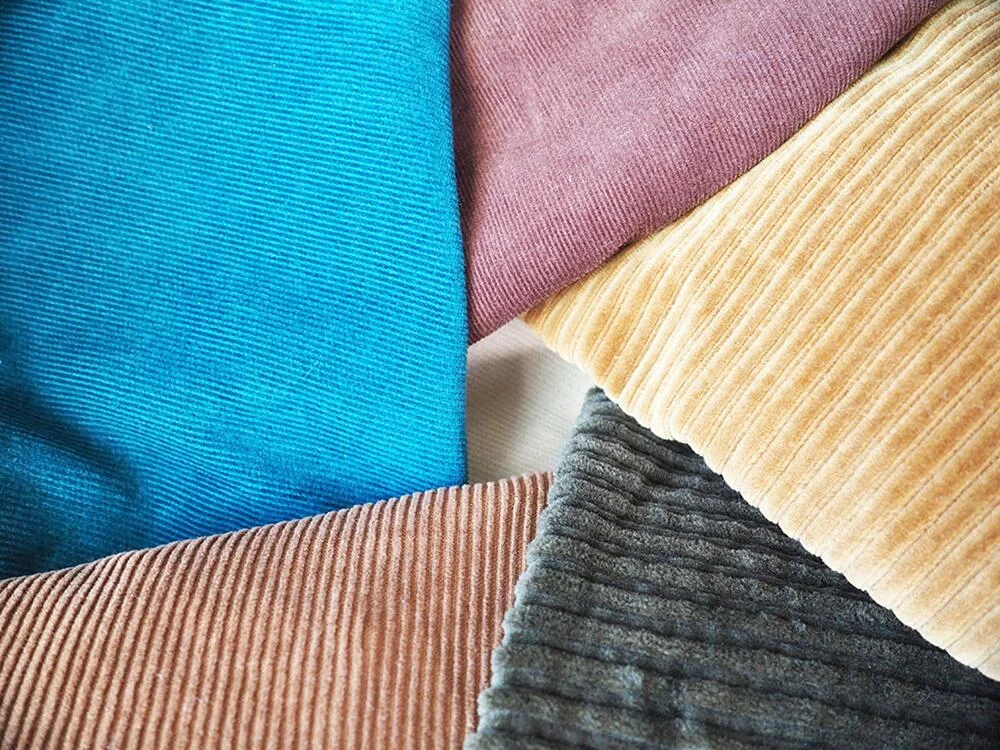
The ribbed texture of corduroy fabric is created by weaving or knitting cotton, resulting in its distinctive raised lines, similar to cords. This unique texture gives corduroy a bumpy feel when touched. Modern corduroy typically features numerous small cords standing upright together.
Corduroy is a durable, warm, and flexible fabric, ideal for clothing. It is commonly used to make pants, jackets, and skirts, favored by many for these applications. Available in a wide range of colors and patterns, corduroy is versatile and adaptable to various design needs.
Corduroy Fabric History
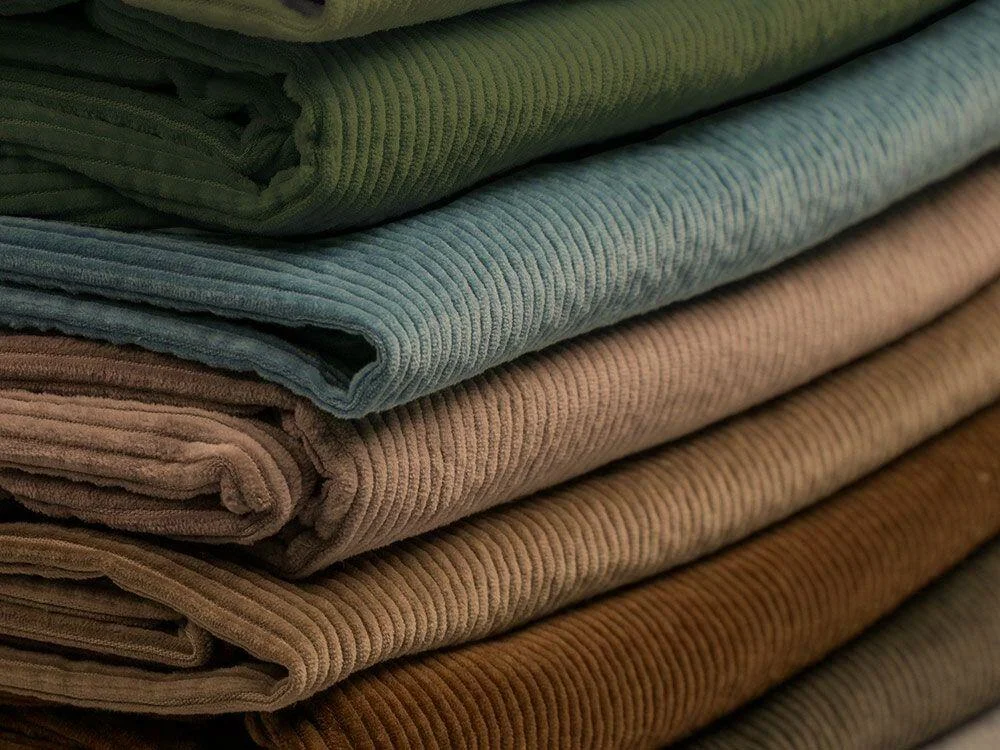
Fabric historians believe that corduroy traces its origins to an Egyptian fabric known as fustian, which was developed around 200 AD. Like corduroy, fustian features raised ridges, but it is much rougher and less tightly woven than modern corduroy.
Modern corduroy was developed by textile manufacturers in England in the 18th century. The exact origin of the name “corduroy” is debated, but one popular theory is unlikely: Some sources claim the name comes from the French phrase corde du roi (cord of the king), suggesting it was worn by French courtiers and nobility, but there is no historical evidence to support this.
More likely, British textile manufacturers adopted the name from “kings-cordes,” which existed in the early 19th century. Another possibility is that the name derives from the British surname Corderoy.
Regardless of its name’s origin, corduroy became highly popular across all levels of British society in the 1700s. By the 19th century, however, velvet had replaced corduroy as the preferred luxurious fabric for the elite, leading to corduroy being nicknamed “poor man’s velvet.”
Corduroy Fabric Texture
Corduroy fabric is distinguished by its ribbed texture, featuring raised lines or “wales” that run parallel along the fabric’s surface. When you touch corduroy, you’ll immediately notice its characteristic bumpy feel, which sets it apart from smoother fabrics.
Types Of Corduroy Fabric
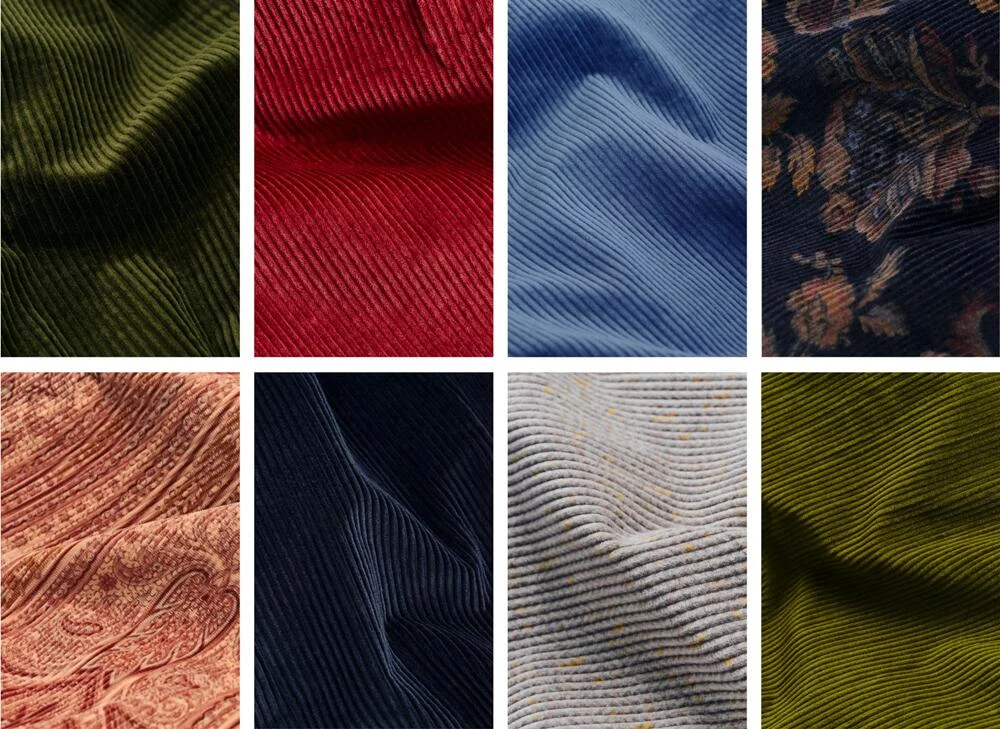
Corduroy fabric comes in various types, each with unique features. Choosing the right type is essential to achieve the desired appearance and texture for your project!
Standard Corduroy
Standard corduroy fabric features narrow, thin cords, typically around 1/8 inch wide, making it the most common type of corduroy material. It has a medium ribbed pattern, is durable, and feels soft and comfortable. On average, corduroy cloth has 11 lines per inch. It is still considered standard corduroy if it has between 8 and 13 lines per inch. This type of corduroy comes in various colors but is often seen in earth tones such as brown, tan, and olive green.
Elephant Corduroy
Elephant corduroy fabric has broader cords and deeper ridges, giving it a more textured and rugged appearance compared to standard corduroy. Often referred to as “elephant cord,” it features large, thick cords that contribute to its distinctive look. Depending on the product, elephant cord fabric can have wales ranging from 1.5 to 6. It is frequently used for upholstery, jackets, pants, and other clothing items because of its durability and unique texture.
Pinwale Corduroy Pinwale
Pinwale corduroy is characterized by thin, spaced cords that resemble a pinwheel pattern. This fabric has a soft, lightweight texture. Unlike elephant cords, pinwale corduroy features numerous tiny ridges per inch of fabric.
In its highest quality forms, pinwale corduroy can have up to 21 ridges, known as “wales,” per inch. It is ideal for clothing items such as shirts, dresses, and skirts. This type of corduroy fabric is popular in warm weather and serves as a versatile layering option in cooler climates.
Pigment-Dyed Corduroy
Pigment-dyed corduroy is a fabric that undergoes pigment dye treatment, resulting in a distinct faded appearance and a soft, well-worn feel. It is commonly used for casual clothing items and accessories like pants, jackets, hats, and bags. Over time, the color may naturally fade, enhancing its vintage appeal.
Spandex Corduroy
Spandex corduroy combines cotton with spandex fiber, providing a stretchy and flexible quality that enhances comfort and ease of movement. This fabric is frequently used for pants, skirts, and jackets due to its versatility. It is also a preferred option for children’s clothing because of its durability.
Bedford Cord
Manufacturers blend cotton, wool, or synthetic fibers to create Bedford corduroy fabric. This fabric has a soft and warm feel, featuring unique “ribs” or ridges. The wide, bumpy lines form an attractive sideways pattern that enhances the appearance of any design.
What Is Corduroy Fabric Made Of?
Corduroy fabric is typically made from cotton, although it can also be composed of other materials such as polyester or a blend of cotton and synthetic fibers. The ribbed texture of corduroy is achieved through a weaving process where extra-filling yarns are woven into the base fabric in parallel lines, creating characteristic wales or ridges.
The quality and feel of corduroy can vary depending on the type of fibers used and the density of the weave, but cotton remains the most common and traditional material for producing this durable and textured fabric.
How Is Corduroy Fabric Made?
The methods for producing corduroy vary based on the materials employed. Natural fibers such as cotton and wool originate from plant and animal sources, while synthetic fibers like polyester and rayon are manufactured in industrial settings.
Once textile manufacturers have obtained the requisite yarns, the production of corduroy fabric adheres to a standardized series of steps:
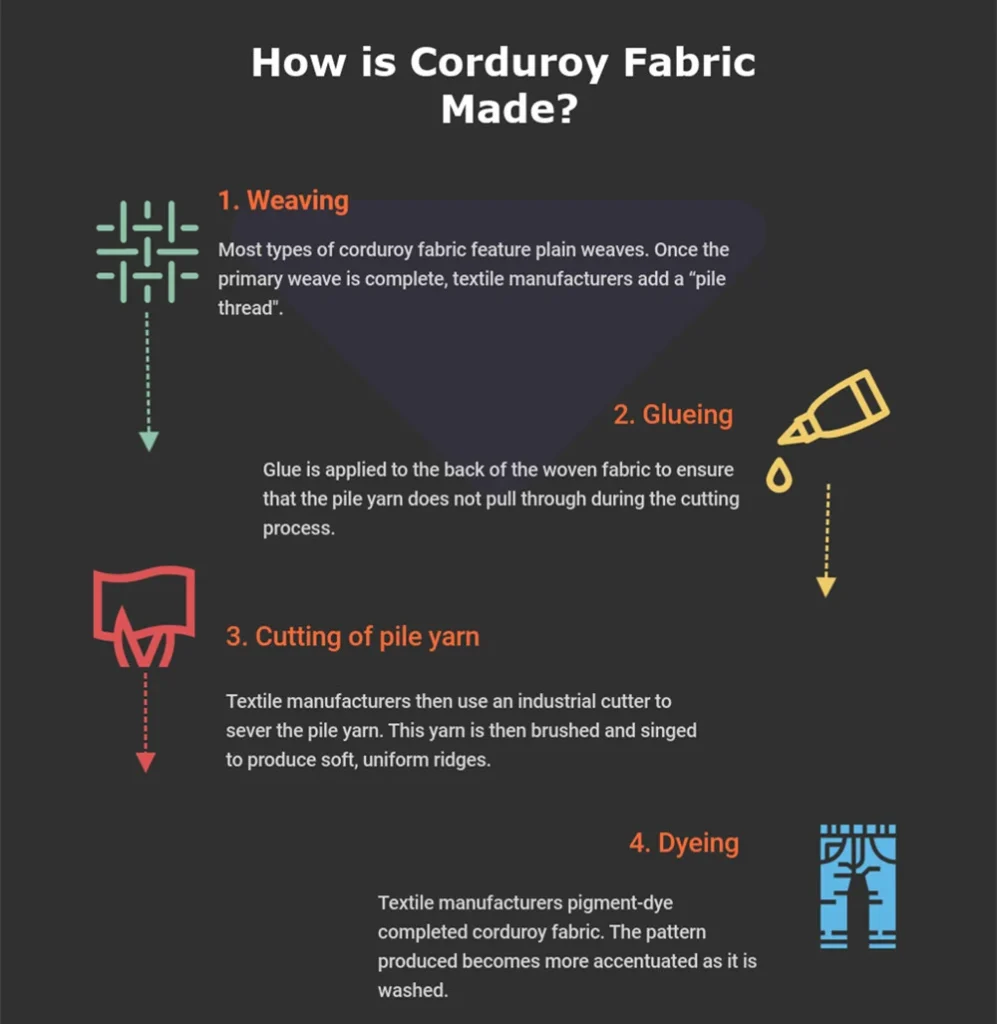
1. Weaving
Corduroy fabric begins with the weaving process, where the base fabric is created using cotton, wool, polyester, or a blend of fibers. Extra filling yarns are woven into the base fabric in parallel lines to form the characteristic wales or ribs that define corduroy.
2. Glueing
After weaving, the fabric may undergo a gluing process where a thin layer of adhesive is applied to the back of the fabric. This helps stabilize the cords and prevent them from shifting during subsequent manufacturing steps.
3. Cutting Of Pile Yarn
Next, the raised cords are created by cutting loops of yarn that protrude from the surface of the fabric. This cutting process is crucial in determining the thickness and appearance of the wales, whether they are wide or fine.
4. Dyeing
Once the cords are cut to the desired height, the fabric is dyed to achieve the desired color. Dyeing can occur at various stages of production, depending on whether the yarns were dyed prior to weaving or if the fabric is dyed after the weaving and cutting processes.
How To Make Corduroy Fabric?
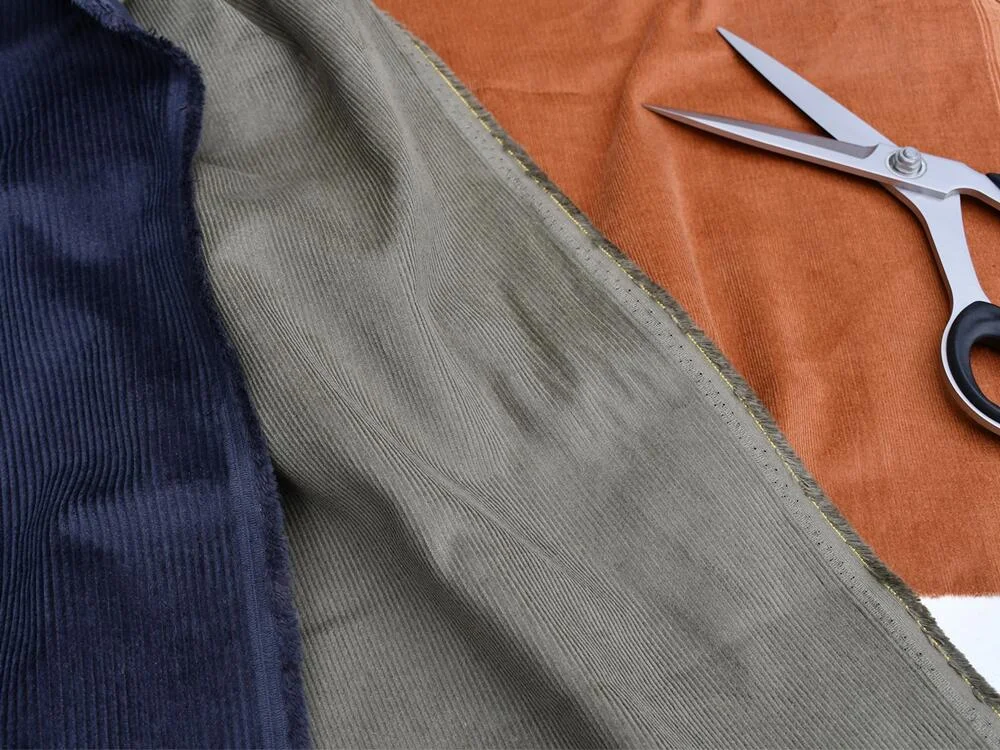
Yarn preparation: First, select the colors, dye the yarn, and spin it onto spools or bobbins. Cotton is the most commonly used fiber for corduroy, though other materials can also be used. The yarn is chosen based on its strength, durability, and texture.
Warping: During the warping stage, weavers use a beam to measure and wind the warp yarns before threading them. The loom, the machine used to weave the fabric, holds the warp yarns vertically, while the weft yarns are wound onto bobbins.
Threading: The weavers thread the warp yarns through the loom in the desired pattern. The weft yarns are then passed over several warp yarns and under one, creating the ribbed texture. Note: The warp is the lengthwise yarn, while the weft is the crosswise yarn.
Tying-up: During the tying-up process, the weavers secure the warp yarns to the loom in preparation for weaving.
Weaving: To make corduroy, weavers interlace the weft yarns with the warp yarns. The weft yarns are passed through the warp yarns using a foot pedal to raise and lower them. To create the raised rib design, the pile yarn is wound onto a beam and then fed through the fabric using needles.
Cutting: The weavers cut the cloth and check its quality during the cutting process.
Finish the corduroy fabric: Once the weaving process is complete, the corduroy fabric undergoes washing and drying. To create an even texture, you can brush or shear the fabric. By following these steps, you can produce a durable and textured corduroy fabric.
Benefits Of Corduroy Fabric
Durability And Longevity
Corduroy is known for its strength and durability. When you choose corduroy, you’re selecting a fabric that can withstand wear and tear, making it ideal for clothing and upholstery that need to last a long time. Its tightly woven structure ensures that it remains resilient even after frequent use and washing.
Comfort And Warmth
You’ll find corduroy to be exceptionally comfortable and warm. The soft texture of the fabric provides a cozy feel against your skin, making it perfect for cooler weather. Its unique ribbed pattern also adds an extra layer of insulation, helping you stay warm and comfortable throughout the day.
Versatility In Style And Function
Corduroy is incredibly versatile, both in style and function. Whether you’re looking for casual or formal wear, corduroy can fit the bill. It comes in various weights and textures, making it suitable for a wide range of clothing items like pants, jackets, skirts, and even accessories. Additionally, its distinctive look can enhance any outfit, adding a touch of vintage charm or modern flair depending on how you style it.
What Is Corduroy Fabric Used For?
In the past, garment manufacturers used corduroy for a wide range of items, including workwear, soldier’s uniforms, hats, and upholstery. Although corduroy is not as popular as it once was, its applications have become more limited.
Fashion Applications
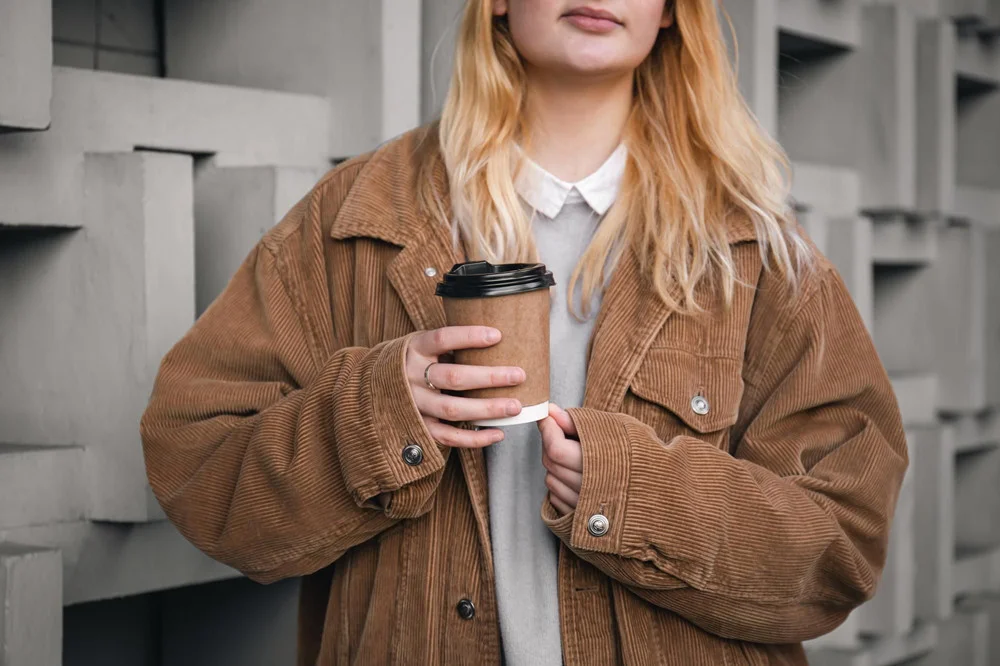
Today, garment manufacturers primarily use corduroy to make overalls (also known as dungarees), pants, and jackets. Although corduroy trousers are not as widely popular as they were in the 1970s, they remain a timeless fashion choice that never completely goes out of style.
Home Decor Uses
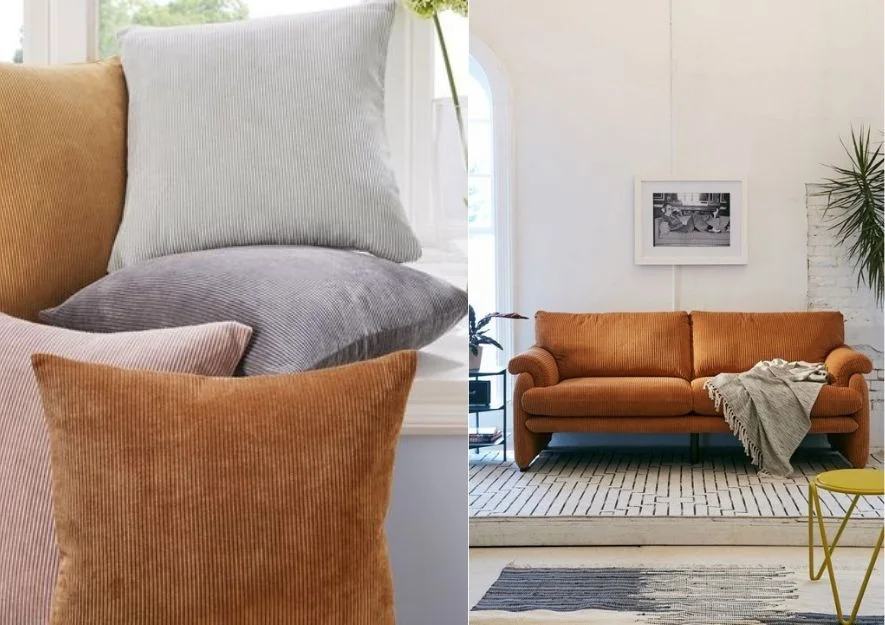
Beyond apparel, furniture, and accessory makers also use corduroy for chair and couch coverings, as well as decorative cushions. In the 1910s, the first automobiles featured corduroy upholstery, but more durable fabrics soon replaced it. While you won’t find corduroy on the seats of modern cars, you might still see this ridged fabric on your friend’s couch.
How To Care Corduroy Fabric?
Taking proper care of your corduroy fabric can help maintain its quality and extend its lifespan. Here are some tips to ensure your corduroy items remain in excellent condition:
Washing And Drying Tips
When washing corduroy, turn the garment inside out to protect the fabric’s surface. Use a gentle cycle with cold water to prevent shrinking and fading. Avoid using bleach, as it can damage the fabric. For drying, either lay the corduroy item flat or tumble dry on low heat. High heat can cause the fabric to lose its texture and shape.
Stain Removal Techniques
To remove stains from the corduroy, gently blot the stained area with a damp cloth and mild detergent. Avoid rubbing, as this can push the stain deeper into the fabric. For tougher stains, use a soft-bristled brush to lift the stain without damaging the ridges. Always test any cleaning solution on a small, inconspicuous area first to ensure it doesn’t affect the fabric’s color.
Storage Recommendations
Store corduroy items in a cool, dry place to prevent mildew and discoloration. It’s best to hang corduroy garments to maintain their shape, using padded hangers to avoid creases. For items that need to be folded, place them in breathable fabric bags to protect them from dust while allowing air circulation. Avoid stacking heavy items on top of corduroy to prevent crushing the ridges.
Conclusion
In conclusion, corduroy fabric combines durability with a distinctive texture that enhances both comfort and style in your clothing and home decor choices. Whether you prefer its classic appeal in pants and jackets or enjoy its versatility in upholstery and accessories, corduroy remains a timeless option. By understanding its qualities and proper care, you can confidently incorporate corduroy into your lifestyle, appreciating its enduring charm and practical benefits for years to come.
